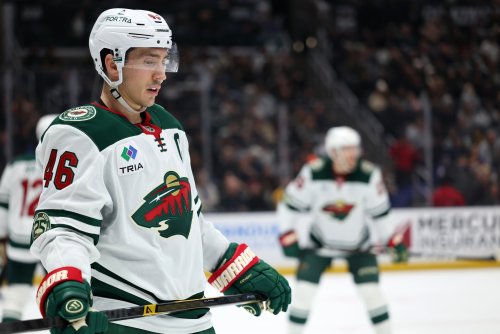
After the 2020-21 season, the Minnesota Wild saw a level of turnover in their defensive core that hadn’t been experienced in years. For a team known for defensive stability, the shocking buyout of Ryan Suter, as well as the additional losses of Carson Soucy, Ian Cole, and Greg Pateryn, created a 2021-2022 campaign where their once trusted blue line needed to be restocked. After all of this change, let’s look back at the new additions and see how they did (relative to their expectations).
Jacob Middleton
Let’s start with the final piece of the puzzle. At the trade deadline, Bill Guerin made clear that he wanted to get bigger and more physical on defense. Additionally, the Wild elected to move on from Kaapo Kahkonen after acquiring Marc-Andre Fleury.
Middleton was shipped to Minnesota for Kahkonen, along with a fifth round pick. His short time in Minnesota lived up to what he was advertised to be. Immediately trusted to play on the top pair with Jared Spurgeon, Middleton’s stay at home nature allowed Spurgeon to feel comfortable jumping up in the rush and allowing his offensive game to shine.
On the offensive side of the puck, Middleton isn’t drawing comparisons to his former teammates Erik Karlsson or Brent Burns. He added a goal and five assists in the 21 regular season games he played, as well as an assist in the Wild’s first round loss to St. Louis. However, it is clearly not what he was brought here to do.
Just like many fans, the Wild clearly enjoyed Middleton, electing this week to give him three more years at a reasonable $2.5 million AAV.
Grade: A-
Dmitry Kulikov
Signed just months after the Ryan Suter buyout, Kulikov was immediately slotted in as a third pairing defenseman. While he spent most of his year in the role, injuries forced a Kulikov into crucial slots of the lineup during the regular season. In these extended roles, Kulikov held his own and was able to demonstrate that his skillset is much higher than the typical third pairing defenseman.
With a larger role, Kulikov found the scoresheet at a rate that he hadn’t since the 2011-2012 season. His analytic numbers also were good, far above what he would be expected to have in his role.
By and large, Kulikov had a comeback year in Minnesota. Many fans were left with a bad taste in their mouth because of Kulikov’s poor performance in the St. Louis series, but it would be a mistake to write off Kulikov over a few bad games. With the Wild in a cap crunch, Kulikov’s $2.25 million cap hit might get dealt to clear some room. However, with top prospects still a couple years from NHL-readiness, Kulikov will likely be an important part of the depth Minnesota claimed as a strength again this year.
Grade: B+
Jon Merrill
Just like Kulikov, Merrill was signed to try to spread out the responsibility that needed to be reclaimed from the Suter absence. At a very inexpensive $850k, Merrill arrived in Minnesota after jumping between Detroit, Vegas, and Montreal. Expectations coming in were relatively contained, but Merrill’s role in the team exploded as the year went on. While he doesn’t play with any flash, he proved to be a responsible and consistent member of the defensive core. With 20 points, he also broke his career point record. His +15 was also a career best.
Clearly, Minnesota was impressed with the consistency that he had to offer. For a team with little money to be uncertain about, the Wild elected to solidify their third pair and extend Merrill for another three years at a raise at a $1.2 million AAV.
Grade: B+
Alex Goligoski
Bill Guerin has been outspoken about his hesitancy to bring hometown players in. He made an exception, however, when he signed veteran defenseman Alex Goligoski at a very generous single year $5 million deal. Pegged as the primary offensive replacement to Suter, although not expected to singlehandedly replace him, Goligoski had some space to fill. At 35 years old, his veteran and high character presence was also desired to help steer a relatively young team.
Goligoski’s ceiling was demonstrated many times throughout the year. At his best, he’s an intelligent offensive defenseman who can move the puck among the best on the team. His experience bleeds through in his patience, another strength of his. At times, especially in the playoffs, Goligoski’s age and small size seemed to hurt him. Either way, he was a consistent offensive contributor from the blue line and was a solid member of the defensive core. In addition to his 30 points, he was an analytic darling.
A string of healthy scratches for Goligoski, immediately followed by a contract extension, served as a pretty effective metaphor of Goligoski’s year. Some games, Goligoski was a clear top four defenseman. Other games, he seemed lost on both ends of the ice. Either way, Goligoski had an overall decent debut year back in his home state.
Grade: B
Think you could write a story like this? Hockey Wilderness wants you to develop your voice, find an audience, and we'll pay you to do it. Just fill out this form.







Recommended Comments
There are no comments to display.
Join the conversation
You can post now and register later. If you have an account, sign in now to post with your account.
Note: Your post will require moderator approval before it will be visible.